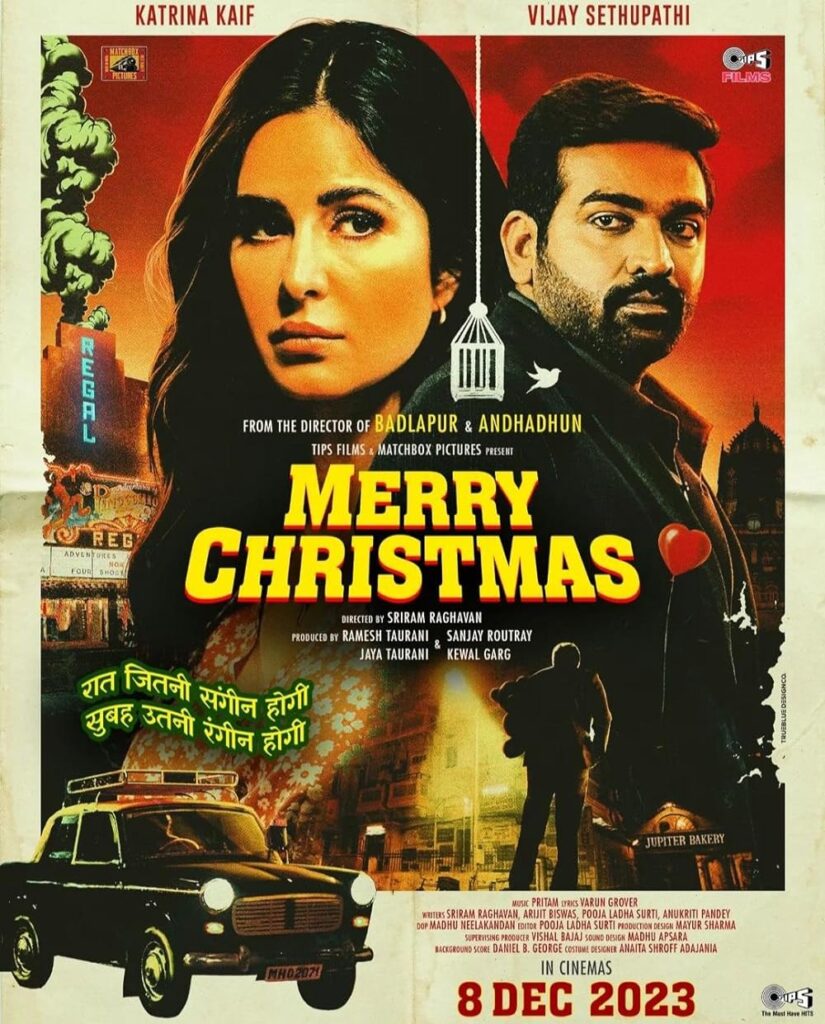In Sriram Raghavan’s latest film, Merry Christmas, a complex web of lies, a murder plot, and an unexpected love story unfolds, drawing inspiration from the pages of the French novel Le Monte-charge by Frédéric Dard. Immersing itself in shadows where humor mingles with intrigue, and drama weaves with subtle suspense, the film creates a world pulsating with hidden motives. Raghavan, renowned for his mastery of crime filmmaking, has consistently captivated audiences with his adept use of cinematic elements and technical prowess in previous works. However, in this sixth feature, the director’s storytelling rhythm appears to languish at a prolonged pace, failing to deliver the expected impact synonymous with his esteemed reputation. Despite moments of brilliance, there’s a persistent feeling that the structural choices might obscure the narrative’s full potential, leaving viewers yearning for the trademark intensity that defines his cinematic legacy. As the story progresses, it becomes apparent that his exploration of deception and sacrifice may have unintentionally sacrificed the rhythmic cadence synonymous with his distinctive storytelling. While the screenplay remains a fascinating exploration of complex emotions the treatment struggles to fully captivate and intrigue the audience.
Set in the vibrant city of Bombay during the 80s, Albert (Vijay Sethupathi) returns from Dubai under pretenses, only to discover his mother’s passing and a palpable emptiness in the house. On the evening of Christmas Eve, to seek solace, he embarks on a nocturnal journey through the intricate streets of the southern part of the metropolis. Fate intervenes as Albert serendipitously encounters Maria (Katrina Kaif), a woman grappling with her misfortune after being stood up by her Christmas date due to the unexpected presence of her daughter. Their eyes lock in a moment of chance, leading to a second encounter within the confines of a theatre. What starts as an ordinary night takes a dramatic turn when Albert, seeking warmth and connection, finds himself entangled in Maria’s old-fashioned apartment. Unbeknownst to him, this seemingly innocuous encounter thrusts Albert into the midst of a mysterious crime scene. The plot thickens, providing Albert with an opportunity to extricate himself from the unfolding intrigue. However, his decision to stay and assist Maria becomes intertwined with a narrative where passion takes unexpected turns, revealing unforeseen alliances and the unraveling of secrets on a night filled with beguilement.

The film ingeniously unfurls with a split screen, employing an artistic canvas that showcases two seemingly mundane mixer grinders. On one side, the rhythmic hum narrates the daily grind of reducing chillies and lentils, encapsulating the essence of routine life. On the other side, a more clandestine operation takes place as tablets are transformed into an enigmatic powder. These parallel processes, initially appearing ordinary, cleverly serve as a metaphorical prelude to the hidden mysteries lurking beneath the surface. When the secrets concealed within these humble grinders come to light, layers are peeled back to reveal the twisted facets of destiny. The screenplay, crafted by the quartet of Raghavan, Pooja Ladha Surti, Arijit Biswa, and Anukriti Pandey, orchestrates a symphony of emotions, a visual feast, and a melodic dance that entices the audience deeper into the enchanting realm of passion and desire. As the night unfolds, the connection between the characters, initially sparked by chance, evolves into a harmony that draws them closer to the edge of their comfort zones. The atmosphere of exhilaration permeating the evening becomes a catalyst, fueling their curiosity and propelling them to explore the uncharted depths of their desires. The film is adorned with dense and opulent visuals, intertwined with a musical ebullience reminiscent of songs from Raja Rani (1973) and Vivaldi’s polyphony, among others. This musical tapestry serves to elevate the mystery enveloping the unexpected romance at the heart of the story.
Woven into the fabric of the narrative is a deliberate and measured pace, an intentional unfolding of moments that anticipates a crescendo of revelation. As Albert lingers in the silent expanse of Maria’s apartment, a subtle tension saturates the air, creating an anticipation that hangs in the room like a delicate thread. However, when the long-awaited moment of revelation finally arrives, it lacks the seismic impact one would expect after such a gradual buildup. The story’s unhurried approach, instead of enhancing its aesthetic allure, exposes a detachment in crafting drama from seemingly uneventful circumstances. Nevertheless, within the serene walls of Maria’s domain, symbolic elements carry deeper meanings. The origami swan, a caged musical bird, and the lone goldfish all bear metaphorical weight. Yet, these elements struggle against the encroaching tedium imposed by the narrative’s measured pacing. Even the insertion of a small flashback sequence, an attempt to shed light on Albert’s past, feels like an overreach—an ambitious narrative choice that disrupts the seamless flow. This disjointed inclusion adds an unnecessary layer of complexity, obscuring rather than enhancing the overall storytelling experience. As we navigate the winding corridors of Albert and Maria’s journey, the promise of becoming engrossed with the story becomes a distant echo, lost in the vast expanse of carefully observed yet unfulfilled moments.

Madhu Neelakandan skillfully imparts a nostalgic atmosphere to the narrative by employing a carefully chosen color palette with his cinematography. The hues not only evoke a retro feel but also craft an ambiance of foreboding, entrapment, and romantic allure within the storyline. Pooja Ladha Surti‘s editing seamlessly integrates each segment, ensuring a smooth flow. However, it struggles to alleviate the overall intrinsic sluggishness present in the film. Madhu Apsara‘s sound design contributes to a well-suited auditory atmosphere, emphasizing diegetic sounds for fluid transitions. Simultaneously, Daniel George‘s background score blends seamlessly with the narrative’s rhythmic ebb and flow. Yet, songs by Pritam Chakraborty, while supporting scene development, lack a memorable melody and are used as a crutch to propel the narrative forward. Mayur Sharma‘s production design effectively captures the film’s essence and period.
Vijay Sethupathi’s predominantly deadpan expression as Albert brings forth a poignant portrayal, eliciting empathy through subtle facial nuances that convey the emotional and psychological turmoil within his character. His chemistry with Katrina Kaif as Maria delicately navigates the film’s edgy landscape, radiating a mysterious allure. While Kaif excels in emotional and lively scenes, she falls short in portraying the darker, malevolent aspects of her character. In the supporting role, Sanjay Kapoor shines as the cheerful and flirtatious caterer Ronni, injecting undulating charm. The pairing of Vinay Pathak and Pratima Kannan as law enforcement officers, along with Ashwini Kalsekar as Ronni’s overprotective wife, provides moments of comic relief. Pari Sharma, portraying Maria’s daughter, is also a delightful presence. However, Tinnu Anand’s portrayal of Albert’s neighbor lacks intricacy, missing an opportunity to enhance the character’s depth.
With Raghavan’s discerning eye and flawless stylistic incorporation, Merry Christmas encapsulates an unforeseen romance amidst secrecy and yearning. However, it stands as the weakest endeavor from a noteworthy figure in Hindi cinema. One might find solace in considering it an experimental choice that, unfortunately, did not quite hit the mark.





